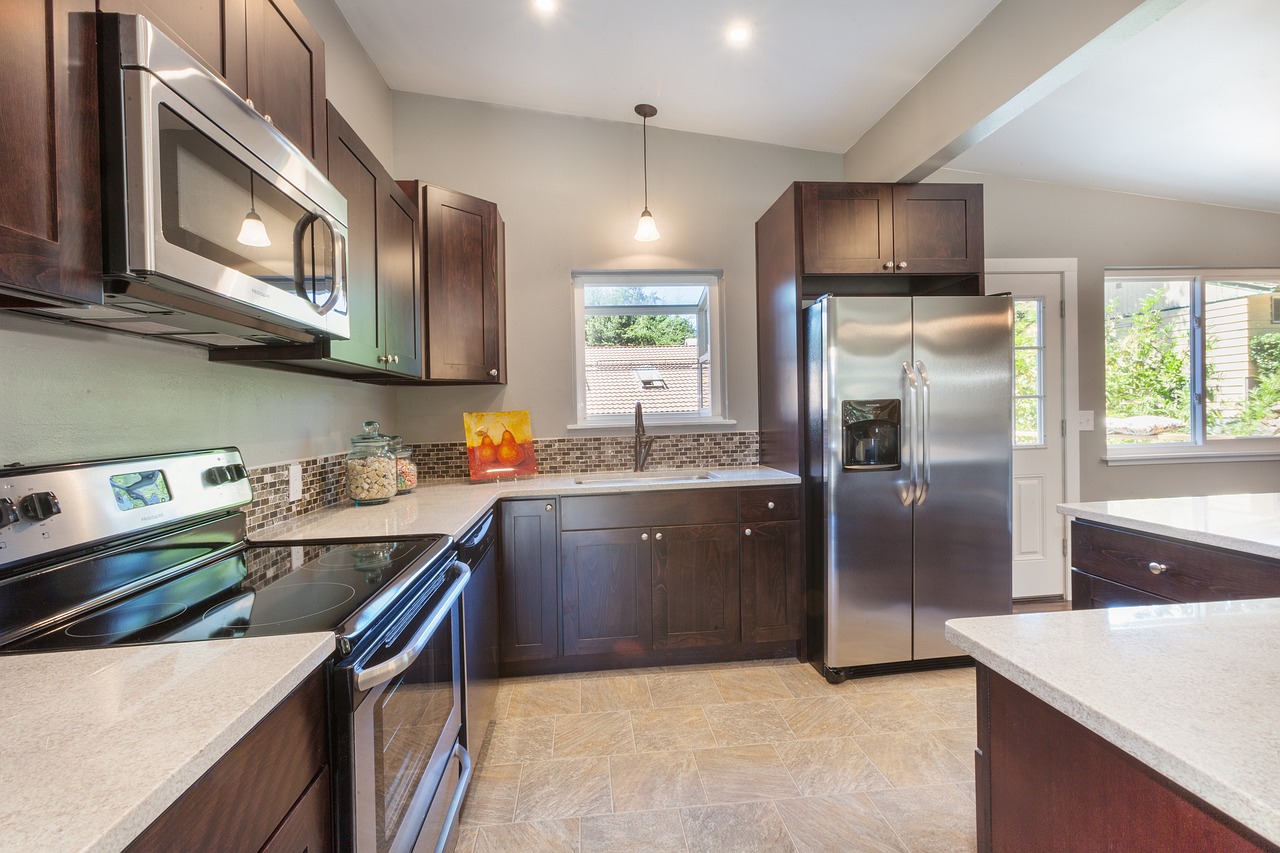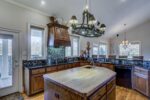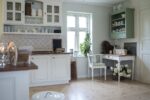It is essential to possess fundamental knowledge about different kitchen cabinet materials, their advantages and disadvantages when installing new kitchen cabinets, replacing old ones, or conducting repairs on existing cabinets. The absence of such knowledge can make it challenging to choose the appropriate material for your kitchen. Although a material may suit your home’s current aesthetics, it may not withstand wear and tear from a household bustling with children.
If one fails to thoroughly investigate the various kitchen cabinet materials, they may be caught off guard by the expense. Though they are known for their longevity, stainless steel, solid wood, and plywood are typically more costly options. Whether the investment is worthwhile depends on the cabinet’s overall construction quality. To gain more knowledge on the subject, consult this informative guide to discover which materials make for the finest kitchen cabinets.
Solid Wood
Solid wood is a popular choice for kitchen cabinets due to its superior strength, longevity, and durability compared to other materials. It has an impressive lifespan and can provide a classic aesthetic to any kitchen if properly maintained. Solid wood is environmentally sustainable and sourced from renewable resources. However, its cost can be higher than most materials apart from stainless steel. Also, since it is porous, it is prone to staining, making it crucial to clean spills immediately and maintain the cabinets regularly. With proper care and maintenance, solid wood kitchen cabinets can be an excellent investment that enhances the beauty and value of your home.
The advantages of using solid wood for kitchen cabinets:
Today, homeowners still favor kitchen cabinets for several reasons that solid wood provides.
- Very Durable
- Beauty
- Long lifespan
- Customizable
- Eco-friendly
Solid wood kitchen cabinets have some disadvantages:
Regrettably, solid wood comes with various disadvantages as well.
- Relatively Expensive
- High Maintenance
- Water Damage
- Termite Infestation
Plywood
In search of kitchen cabinet materials that are affordable, easy to maintain, resilient, and lightweight? Opt for plywood, an engineered wood substance manufactured in production facilities. Composed of multiple layers of authentic wood, waste timber, shredded wood fibers, MDF, and particleboard, plywood is expertly bonded to create a robust and durable material suitable for kitchen cabinets.
The Layers of Plywood in the Common Core:
- Veneer-core
- Fiber-core
- MDF-core
- Particleboard-core
- Lumber-core
- Combine-core
Plywood is a lightweight option that is simpler to install and handle compared to denser materials such as solid wood. Moreover, it is simple to fix and smoothen out in case of any indentation, dents or scratches. If you’re looking to reduce your material expenses, plywood is a great choice. Despite being pricier than certain wood substrates or synthetic wood products, it is still more economical than solid wood or stainless steel. However, when selecting plywood for your cabinets, you need to be careful as you may come across defects like knots, gaps, and thinner planks that could weaken the cabinet, particularly if it is overloaded.
Advantages of Using Plywood for Kitchen Cabinets:
- Save money
- Lightweight
- Medium durable
- Easy to repair
Drawbacks of using Plywood for Cabinets in the Kitchen:
- Warps easily
- Vulnerability to Moisture
- Easily Damaged
- Prone to Warping
Particleboard
Particle board is crafted by combining wood chips, sawdust, wood shavings, and other wooden components using a resin under substantial heat and pressure, producing a composite wood article. It is a cost-effective substitute for customary plywood and frequently utilized in carpentry, cabinets, and other furniture constructions. Particle board is generally lighter and cheaper than plywood, but its durability is lower and vulnerability to harm from water or humidity is higher due to its propinquity to moisture. This sort of product is also more prone to warping and cracking, which can be problematic in fixtures or other uses. Furthermore, Particle board is environmentally friendly as it is made from waste materials that would otherwise be discarded, and many plywood producers employ their leftover material to produce particle boards, rendering them more affordable.
Advantages of using Particleboard for Kitchen Cabinets:
- Very cost-effective
- Lightweight
- Easy to Cut & Custom
- DIY Friendly
Negative Aspects of Using Particleboard for Kitchen Cabinets:
- Poor Durability
- Unattractive Appearance
- Potentially Toxic
- Low Resale Value
- Difficult to Repair
Melamine Wood
Cabinets are frequently constructed with melamine, a synthetic material produced from resin and plastic. This sturdy substance, which boasts a durable and long-lasting finish, is often utilized as an overlay for MDF, Plywood, and Particleboard. The creation of melamine wood entails a thermosetting procedure that involves subjecting the melamine resin and particleboard core to elevated pressure, resulting in a sturdy bond. This bond is responsible for the ability of melamine wood cabinets to withstand extensive use. Additionally, the finish that is attained is both stylish and elegant.
Melamine is favored for kitchen cabinets due to its durability, low maintenance, and affordability, making it an ideal option for numerous homeowners. The material boasts high strength to withstand regular use and comes in various hues, textures, and sheens, allowing for easy customization that suits any residence. Additionally, Melamine requires minimal upkeep, making it a practical selection for families with packed schedules.
There are various benefits of using melamine wood for kitchen cabinets:
- Very cost-effective
- Water Resistance:
- Resistant to scratches, chips, and dents.
- Lightweight
- Easy to Cut & Custom
- DIY Friendly
Disadvantages of using Melamine Wood in Kitchen Cabinetry:
- Not pair well with nails and screw
- Need Pro to install
- Unattractive Appearance
- Low Resale Value
- Difficult to Repair
Wood Veneer
Would you like to achieve the appearance and feel of natural wood in your home without breaking the bank? Consider using wood veneer cabinets! Wood veneer cabinets are constructed from genuine wood, but are thinner and more affordable. A thin layer of actual wood is applied to a base substrate, such as MDF, HDF, or Particleboard, in order to lower costs. This means you can have the exquisite, natural wood look for a fraction of the price. Moreover, wood veneer cabinets provide the same long-lasting, durable, and scratch-resistant qualities as conventional cabinets. Therefore, if you want an economical method to incorporate natural wood into your living space, choosing wood veneer cabinets is an excellent choice!
There are numerous advantages to using wood veneer on kitchen cabinets.
- Look Like Natural Wood
- Low Cost than Natural Wood
- Variety in design
- Strength and Durability
- Eco-Friendly
The Disadvantages of Utilizing Wood Veneer on Kitchen Cabinets
- Water Damage
- Need Pro installed
- More Maintenance
- Hard to Repair
Laminate
If you’re searching for a stylish and enduring addition to your kitchen, laminate cabinets are an excellent choice. They’re constructed from a robust core material, usually MDF or wood particleboard, and melamine, and are bonded under high pressure to create a sturdy connection. The versatility of laminate cabinets allows for extensive customization, giving you the opportunity to craft the ideal look for your kitchen. In addition to their appealing appearance, these cabinets are highly resistant and will endure for many years. Therefore, if you want to enhance the aesthetics of your kitchen, opting for laminate cabinets is undoubtedly the right course of action.
Benefits of using laminate material for cabinets.
- Easy to clean
- Affordable cost
- DIY Friendly
- Resistant Scratch and stain
The disadvantages of using laminate for cabinets
- Lack of Resale Value
- Susceptible to Moisture Damage
Thermofoil
Cabinets in kitchens and bathrooms are commonly made of Thermofoil wood, which is crafted by molding a PVC vinyl film substance onto a substrate composed of wood, particleboard, or medium-density fiberboard (MDF) and then subjected to heat. This results in a rugged and long-lasting surface which is simple to keep clean and maintain. Moreover, it is cost-efficient, making it an appealing choice for homeowners who are careful with their money.
A range of hues and finishes is available for thermofoil wood cabinets, enabling you to achieve a personalized appearance that complements any decor. In addition, its sealed exterior prevents staining and combatting warping and discoloration. Yet, thermofoil wood is not heat and sunlight resistant, requiring the avoidance of hot apparatuses and direct sunlight. Nonetheless, giving it the proper upkeep and maintenance can lead to the cabinets remaining aesthetically pleasing and lasting for an extended period of time.
Despite the fact that they are made of different materials, Thermofoil cabinets are often confused with Melamine and Laminate ones, which utilize melamine plastic. Thermofoil, on the other hand, is constructed from vinyl. It is important to note that Thermofoil is thicker, has a softer texture, is easier to remove, and is more adaptable in order to distinguish it from the others.
Advantages of Thermofoil in Kitchen Cabinetry
- Cost-Effective
- Durable
- Easy to Clean
- Variety of colors and textures
- Resistant scratches, scuffs
Disadvantages of using Thermofoil for kitchen cabinets.
- Difficult to refinish
- Very vulnerable to heat damage
Medium-Density Fiberboard (MDF)
Ideal for: Variety of styles and finishes that fit different budgets.
When opting for kitchen cabinets, MDF or Medium Density Fiberboard is a prevalent choice. It is denser compared to hardwood and permits the attainment of a seamless finish sans the texture of grain that solid wood or plywood cannot provide. Additionally, MDF can withstand water and mold, qualifying it as an ideal option for high-moisture areas like the kitchen.
MDF material or MDF cabinetry is available in various styles and finishes, and can be customized in terms of size by cutting it and by applying laminate to enhance its design. Nonetheless, it is important to bear in mind that MDF is not as long-lasting as other cabinet materials, and exposing it to high temperatures can cause significant harm to this type of kitchen cabinetry.
Stainless Steel
Suitable for: Longevity, ability to withstand high temperatures, ability to repel water, and low maintenance requirements.
Although stainless steel is not a commonly chosen material for kitchen cabinets in residences, it is often utilized in crafting cabinets for commercial kitchens due to its exceptional sturdiness, prolonged existence, and simplicity in cleansing. The sleek metal exteriors can be swiftly and effortlessly wiped down, eradicating all forms of dirt, filth, grease, and additional unwanted materials.
Due to its heat and water resistance, users need not be concerned about inadvertently damaging their kitchen cabinets with hot pans or wet cookware. Nevertheless, the hefty cost of stainless steel kitchen cabinets and the limited range of designs available with this robust material are significant drawbacks.
High-Density Fiberboard (HDF)
Ideal for: Compactness, designs, cost-effectiveness, and artwork.
HDF, also known as high-density fiberboard, is a cost-effective material that is ideal for creating kitchen cabinets, much like MDF. It is frequently utilized to produce kitchen cabinet panels that resemble the hardness and appearance of solid wood cabinetry. HDF is an inexpensive and denser option compared to hardwood or plywood, making it a fantastic option for budget-conscious DIYers.
Although HDF doesn’t have good grip for screws or nails, it’s a suitable choice if you intend to paint the cabinets. HDF maintains its stability in environments with high or low humidity, but water damage is likely to occur, therefore, it’s crucial to ensure that dishes, cups, and other kitchenware are adequately dried before storing them in an HDF cabinet.
Choosing a Kitchen Cabinet Material
Your choice of material for kitchen cabinets is primarily based on personal preference, but there are additional factors to consider beyond appearance. In particular, it’s crucial to assess the strength and durability of the cabinets, especially if children or individuals who are tough on cabinetry will be living in the home. While stainless steel is a durable material used frequently in commercial kitchens, it isn’t a common selection for residential kitchens. Therefore, if durability is your top priority, you may want to opt for cabinets constructed from plywood or solid wood.
It is important to remember that superior materials are pricier compared to wood substrates, wood veneers, or any other manufactured wood elements used for kitchen cabinets. The use of HDF and MDF can be a feasible substitute for kitchen cabinets. They are light in weight, affordable and fairly simple to handle. Other inexpensive options like thermofoil, laminate, and melamine, which imitate the semblance of wood, are perfect for those on a budget wanting to enhance their kitchen’s appearance.






